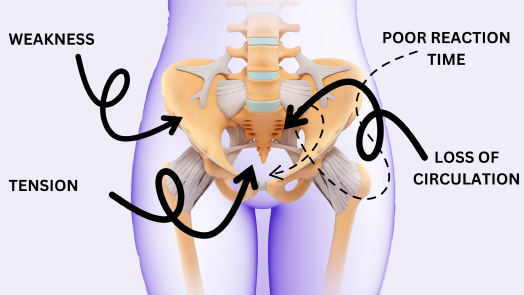Restore Your Pelvic Floor Health: A Simple, Effective Method to Regain Control

It’s time we stop accepting the myths surrounding women’s pelvic health. The idea that light bladder leakage, pelvic organ prolapse, or incontinence is “just part of being a woman” is not only inaccurate, it’s damaging. These issues don’t have to be your reality, and certainly, they aren’t something you need to suffer through in silence.
The good news? Restoring your pelvic floor health is easier than you think—and you don’t need invasive surgery or medications to see improvement. All you need is just 10 minutes a day and the right set of exercises. I’m going to walk you through the proven methods that have helped thousands of women like you regain control of their pelvic floor.
Why You Should Care About Your Pelvic Floor
Your pelvic floor is a group of muscles and tissues that support important organs—like your bladder, uterus, and rectum. Unfortunately, these muscles can weaken over time due to factors like pregnancy, childbirth, aging, and even heavy lifting. When the pelvic floor weakens, it can result in issues like stress urinary incontinence (SUI) and pelvic organ prolapse (POP), both of which can significantly affect your quality of life.
But here’s the thing: these issues are not inevitable. They don’t have to define you or dictate your lifestyle. With the right approach, you can strengthen your pelvic floor and say goodbye to the embarrassment of leaks, prolapse, and discomfort. The secret is in how you care for and train these muscles.
The Kegel Method: A Proven Way to Restore Pelvic Floor Function
You’ve probably heard of Kegel exercises, and for good reason. They’re widely regarded as one of the most effective ways to re-train your pelvic floor muscles. But not all Kegels are created equal. The secret to success lies in doing them properly and consistently.
Here’s How to Do Kegel Exercises the Right Way:
-
Find Your Pelvic Floor Muscles: The first step is to locate the right muscles. A simple way to do this is by stopping the flow of urine midstream. The muscles you use to do this are your pelvic floor muscles.
-
Perform Kegels: Once you've identified your pelvic floor muscles, contract them by squeezing and lifting. Hold for 5 seconds, then relax for 5 seconds. Repeat this for 10-15 reps, at least three times a day.
-
Gradually Increase Intensity: Over time, try to hold the contraction for 10 seconds, and work your way up to 20 reps per session.
These exercises are a game-changer for women suffering from urinary incontinence and pelvic organ prolapse. They’re simple, effective, and can be done anywhere—whether you're at home, at work, or even sitting in traffic.
Why Kegel Exercises Work: A Holistic Approach to Healing
Many women are skeptical about the effectiveness of pelvic floor exercises. After all, it seems too simple to solve such complex issues, right? But the truth is, Kegels work because they address the root causes of stress incontinence and prolapse.
The pelvic floor muscles are like any other muscles in your body—they can become weak, tight, or uncoordinated. Kegels re-train these muscles to:
- Relax tight muscles that contribute to prolapse.
- Strengthen weak muscles that cause incontinence.
- Encourage proper coordination between muscles for optimal function.
This holistic approach is why the Kegel method has been so successful for thousands of women, from postpartum moms to those in their 90s.

Other Exercises for Pelvic Floor Health
Kegels are incredibly powerful, but you can take your pelvic health to the next level by incorporating other pelvic floor-friendly exercises into your routine.
-
Bridge Pose: This simple yoga move targets your glutes and pelvic floor muscles. Start lying on your back with knees bent. Lift your hips toward the ceiling, squeeze your glutes, and engage your pelvic floor. Hold for a few seconds and lower slowly.
-
Squats: Squats aren’t just great for your legs—they also engage your pelvic floor. Stand with feet shoulder-width apart, bend your knees, and lower into a squat. As you rise, squeeze your pelvic floor muscles.
-
Hypopressive Breathing: This technique involves deep abdominal breathing combined with pelvic floor engagement. It helps alleviate pelvic organ prolapse by strengthening the core and pelvic floor simultaneously.
By combining these exercises with your daily Kegels, you’ll give your pelvic floor the comprehensive support it needs.
Real-Life Success Stories: You’re Not Alone
I want to share a few success stories that highlight how this approach can truly transform your life:
-
Rachel, 45: After three pregnancies and years of suffering from SUI, Rachel couldn’t even laugh without worrying about leakage. After just four weeks of doing Kegels and pelvic floor exercises, she regained control and was able to enjoy running again without fear of leaks.
-
Lydia, 62: Lydia had been living with pelvic organ prolapse for over 15 years. She was told surgery was her only option. Instead, she began practicing Kegel exercises combined with core strengthening, and her symptoms completely reversed in three months.
These are just two of the countless women who have transformed their pelvic health through exercise, and you can too.



Additional Tips for Maintaining Pelvic Floor Health
In addition to pelvic floor exercises, maintaining overall health is essential for long-term success. Here are a few extra tips for keeping your pelvic floor in top shape:
- Stay active: Regular exercise, including walking and swimming, helps maintain pelvic floor strength.
- Avoid heavy lifting: Lifting too much weight can put unnecessary pressure on your pelvic floor. If you must lift, remember to engage your pelvic muscles.
- Eat fiber-rich foods: Constipation can strain your pelvic floor. A diet rich in fiber will help prevent this issue.
Conclusion: You Have the Power to Heal
Pelvic floor issues don’t have to define your life. You don’t need to settle for pads, medications, or surgery. By committing just 10-15 minutes a day to the right pelvic floor exercises, you can restore your pelvic health, regain control over your bladder, and live with confidence.
Remember, it's never too late to start. Whether you're in your 30s, 50s, or beyond, your body can heal. Let’s stop accepting the myths about pelvic floor health and start taking action—today.
References:
- Dumoulin, C., & Hay-Smith, E. J. C. (2010). Pelvic floor muscle training for urinary incontinence in women: A systematic review of randomized controlled trials. Cochrane Database of Systematic Reviews, (1).
- Bø, K., & Berghmans, B. (2019). Pelvic floor muscle training: What are we doing?. International Urogynecology Journal, 30(3), 403-410.
- Sapsford, R. (2018). Pelvic floor muscle function and dysfunction: Implications for rehabilitation. Physiotherapy Theory and Practice, 34(7), 539-545.
- Smith, H. W., & Knobel, S. (2012). Impact of prolapse and incontinence in women’s health: The importance of pelvic floor health. International Journal of Women’s Health, 4, 45-52.
- Kegel, A. H. (1952). The treatment of urinary incontinence in women. American Journal of Obstetrics and Gynecology, 63(5), 1-9.

 SOFA COVERS
SOFA COVERS
 Magic Sofa Covers
Magic Sofa Covers
 Miracle Sofa Covers
Miracle Sofa Covers
 Magic Sofa Mat
Magic Sofa Mat
 Magic Sofa Blankets
Magic Sofa Blankets
 FABRIC ARCHIVE
FABRIC ARCHIVE
